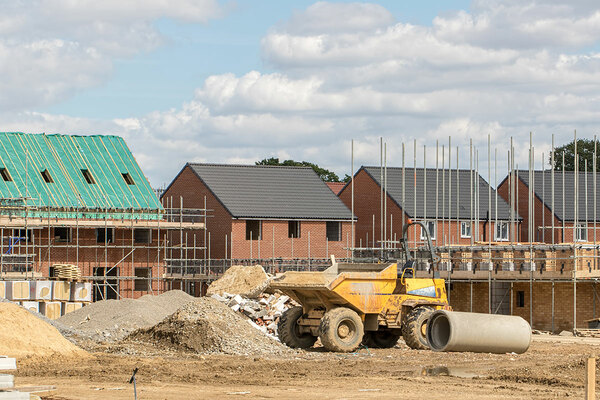You are viewing 1 of your 1 free articles
Councils are using a variety of models to become a major ‘third force’ in housebuilding
The abolition of the debt cap is just one method councils are using to increase their development output, writes Scott Dorling
Only a few years ago “new council housing” would have seemed an odd headline, but now it raises no eyebrows.
Councils have the regulatory and financial framework within which to build. Government is supportive. Any lingering issues to do with political trust have been lost in the overriding need for more homes. The Housing Revenue Account (HRA) debt cap has been removed and the four years of rent reductions have come to an end – with the reassurance that at least for the next five years councils as well as housing associations will benefit from a 1% (real) rent rise.
And when councils ask for the various consents from government, they are more likely to get a yes than a no – although we know that the secretary of state is personally reviewing all such requests.
There may be some concern about the differences between a Theresa May-led government than a Boris Johnson-led one, but the overall context for new council housing remains benign.
Hence the confidence with which councils are building (or at least contemplating building) homes again.
Even those with no stock (and therefore no HRA) anymore are doing so – and many of these are going beyond the 200-unit maximum and accepting that they have to hold the homes in a reopened HRA. Liverpool City Council is the most high-profile example.
There are, however, still constraints that give councils pause. The HRA itself, existing or reopened, still operates by reference to the well-known ‘ringfence’ and councils worry about this inflexibility, when they contrast the self-financed HRA with their hard-pressed general fund. Politics may point to ‘council homes’ but financial considerations might point elsewhere.
Then there is the Right to Buy and this remains a major disincentive, notwithstanding the application of the cost-floor rule and the possibility of retaining (subject to the controversial replacement rules) receipts from sales.
The new regulation of council rents (from April 2020) introduces potential problems with viability or at any rate removes the flexibility inherent in Section 24 of the Housing Act 1985. Five years’ worth of Consumer Price Index plus 1% is attractive but the overall concept of regulation might be less so.
Finally, there are competing pressures for the use of surplus revenue. Converting rental income to capital (revenue contribution to capital outlay) to meet the expensive and pressing requirements of building safety means that servicing uncapped borrowing will be more difficult.
All of which explains why councils will continue to look closely at local housing companies (LHCs), ie companies wholly owned by their ‘parent’ council. They have been set up for various reasons.
Many have been aimed at sub-market housing, often to provide homes for key workers. Some have been positioned to ‘lead’ the local market, trying to encourage private sector developers to follow. A few have been established to assist with financial support for the general fund.
Many LHCs are still operating at a modest scale; some are yet to develop or acquire properties. Others, however, are developing at pace and scale.
For the most part LHCs have relied on their councils for funding, in the form of on-lent borrowing from the Public Works Loan Board – and so far the signs are that the increase in PWLB rates has not had a material effect, although the impact on development business plans are still being worked through.
“This spectrum of approaches to the delivery of new council housing affords plenty of scope for councils to adopt the model that suits their political and other circumstances”
LHCs have also begun to play a role in lease-based arrangements promoted by institutional investors.
In its simplest form a local authority will lease a site to an investor on a long lease and the investor will grant a leaseback to the LHC. The rent will be index-linked (subject to caps and collars) and the council will guarantee the LHC’s obligations.
If all goes according to plan, at the end the leaseback the council will purchase the remainder of the head lease and the council will be the unencumbered owners of the ‘council’ homes.
Then there is the role of partnerships – contractual or even corporate – between councils and developers or housing associations. They are often established in the context of complex regeneration schemes but they are also used for “pure” new build.
We are expecting to see more partnerships of this kind, particularly based on the limited liability partnership model.
This spectrum of approaches to the delivery of new council housing affords plenty of scope for councils to adopt the model that suits their political and other circumstances.
The potential numbers are very significant. The bulk of new homes may continue to be delivered by housing associations on the one hand and private sector developers on the other. But councils (directly or indirectly) are once more becoming a powerful third force.
Scott Dorling, partner, Trowers & Hamlins
Councils with the top 50 biggest development plans over the next five years (2019/20 - 2023/24)
| Council | Total | HRA | Housing company | General fund | Notes |
|---|---|---|---|---|---|
| Havering | 5,438 | 3,000 | 2,438 | 0 | Driven by "12 estates" regeneration programme |
| Barking and Dagenham | 3,290 | 19 | 3,088 | 183 | Largely through BeFirst housing company |
| Croydon | 2,928 | 4 | 2,916 | 8 | 500 a year through Brick by Brick |
| Newham | 2,656 | 1,056 | 1,600 | 0 | |
| Sheffield | 2,409 | 1,112 | 1,297 | 0 | |
| Hackney | 2,121 | 1,421 | 0 | 700 | |
| Ealing | 2,037 | 536 | 1,501 | 0 | |
| Enfield | 1,924 | 1,026 | 0 | 898 | |
| Southwark | 1,846 | 1,846 | 0 | 0 | |
| Hammersmith and Fulham | 1,800 | 1,800 | 0 | 0 | |
| Hounslow | 1,549 | 885 | 664 | 0 | |
| Norwich | 1,525 | 1,250 | 275 | 0 | |
| Leeds | 1,500 | 1,500 | establishing company | not yet known | |
| Gateshead | 1,491 | 167 | 866 | 458 | |
| Wolverhampton | 1,388 | 529 | 859 | 0 | |
| Cornwall | 1,320 | 320 | 1,000 | 0 | |
| Westminster | 1,244 | 541 | 311 | 392 | |
| Greenwich | 1,203 | 750 | 226 | 227 | |
| Newcastle upon Tyne | 1,200 | 250 | 600 | 350 | |
| Birmingham | 1,167 | 1167 | 0 | 0 | |
| Southampton | 1,000 | 1,000 | not yet known | not yet known | |
| Stockport | 1,000 | 500 | 500 | not yet known | |
| Haringey | 1,000 | 1,000 | 0 | 0 | |
| Windsor and Maidenhead | 963 | 0 | 113 | 850 | |
| King's Lynn and West Norfolk | 912 | 0 | 0 | 912 | Some may be delivered through a housing company |
| Barnet | 879 | 373 | 506 | 0 | |
| Islington | 875 | 625 | 0 | 250 | |
| Crawley | 849 | 758 | 0 | 91 | |
| Lewisham | 828 | 300 | 281 | 247 | |
| Cambridge | 814 | 521 | 293 | 0 | |
| Blackpool | 769 | 269 | 500 | 0 | |
| Bournemouth | 701 | 195 | 428 | 78 | |
| Milton Keynes | 700 | 500 | 200 | 0 | |
| Welwyn Hatfield | 688 | 247 | 150 | 291 | |
| Stoke-on-Trent | 680 | 400 | 280 | 0 | |
| Nottingham | 671 | 468 | 203 | 0 | |
| Medway | 648 | 48 | 600 | 0 | Also planning more HRA developments with numbers not yet known |
| Harrow | 639 | 639 | 0 | 0 | |
| Wandsworth | 625 | 625 | 0 | 0 | Based on 1,000 over 8 years |
| Harrogate | 600 | 500 | 100 | 0 | |
| Rotherham | 600 | 600 | 0 | 0 | |
| York | 600 | 600 | 0 | Not yet known | |
| Kensington and Chelsea | 600 | 600 | Still deciding the mix of delivery mechanisms | ||
| South Norfolk | 598 | 0 | 598 | 0 | |
| Winchester | 550 | 500 | 50 | 0 | |
| Oxford | 548 | 0 | 548 | 0 | |
| Dacorum | 506 | 300 | 206 | 0 | |
| Bexley | 500 | 0 | 500 | 0 | |
| Darlington | 500 | 500 | 0 | 0 | |
| Northampton | 500 | 500 | 0 | 0 |
Source: Reponses from local authorities to requests made under the Freedom of Information Act













